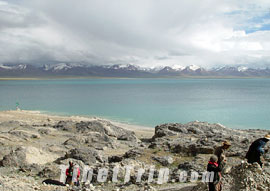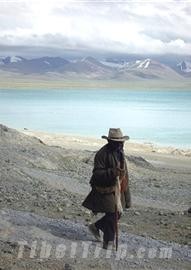
The scenery at Namtso is beautiful and magnificent. Mt. Nyainqentanglha standing to the southeast of the lake, soars to a height of over 7, 100 meters (23, 294 ft) above sea level, and is snow-capped throughout the year. The lake's northern side is bounded by gently undulating hills that form this part of the continental plateau. Melted ice and snow from the surrounding mountains are the major source of the pure and clean waters of this placid lake which has a typical emerald hue due to the high mineral content. Encircled by vast grasslands, the lake resembles a huge mirror. The lakeside plain provides a natural pasture where herdsmen graze their cattle and sheep. Here too is an abundance of wildlife that includes birds, ducks, bears, yaks, donkeys, blue sheep, foxes, river deer and Himalayan marmots, while the lake teems with fishes and is a source of precious medicinal materials. Numerous mani stones and colorful prayer flags can be seen all around the shore and these add another touch of brilliance to the scenery. The azure blue sky dotted with white clouds, the greenish lake water, and white snow, swathes of green grasses, red mani stone piles, multicolored flowers enhance the beauty of the area and together with the lively animals form a picturesque view of nature. It is small wonder that visitors had been to the lake say that they enjoy spiritual refreshment and a heart gladdening feeling when they stand beside Namtso.
 At the end of the twelfth century, eminent monks of the Tibetan Kagyu school of Buddhism came to Namtso to practice their religion. They considered that this lake was the seat of Chakrasamvara of Esoteric Buddhism and they pioneered the practice of circumambulation around the lake. Later, Buddhists came to believe that during each Year of the Sheep in the Tibetan calendar, Buddhas, Bodhisattvas and Vajras assemble at this place. They also believe that during these auspicious occasions the chanting of scriptures and making a circumambulation of the lake is equal to doing them ten thousand times at other times. So each April to June in the Year of the Sheep, numerous pilgrims trek many miles from all over Tibet and other provinces, such as Qinghai, Gansu, Sichuan and Yunnan as well as from India and Nepal. It takes twenty to thirty days to circumambulate the lake just once so today most of the people walk around an islet of the lake instead. Pilgrims drop a pebble each time they encounter a pile of mani stones, as they believe this is equivalent to a single chant, thus a wall of mani stones, that is over one hundred meters (328 ft) long has been formed. Many lamas dwell all year-round on a hill beside the lake and practice Buddhism, while replying on the offerings of local Tibetans for their livelihood.
Currently, it is not easy to get to Namtso since there is no public transport available. The overland journey from Lhasa takes in excess of four hours and not the entire road has been macadamized. There is also a snow covered mountain pass of over 5, 100 meters (16, 732 ft) high to cross. During the rainy season, which is usually from June to August, the road can be damaged or even completely destroyed and some places may turn to a swamp, so vehicles with a low chassis are not suitable for the trip. To make an overnight stay is difficult or even dangerous due to the high altitude. There is no electric power or tap-water, no hotels but only a few shabby rooms and restaurants. During peak tourist periods, many people have to stay outside in tents. The temperature varies greatly between daytime to nighttime. Heavy rains and hail storms frequently happen at night so a down jacket is necessary even in summer. It is recommended that people should stay for a week or more in Lhasa or other place with a comparatively lower altitude in order to acclimatize before going to Namtso. This is because going yet another 1, 100 meters (3, 609 ft) higher in too short a time the altitude likely to cause a serious altitude reaction.
At the end of the twelfth century, eminent monks of the Tibetan Kagyu school of Buddhism came to Namtso to practice their religion. They considered that this lake was the seat of Chakrasamvara of Esoteric Buddhism and they pioneered the practice of circumambulation around the lake. Later, Buddhists came to believe that during each Year of the Sheep in the Tibetan calendar, Buddhas, Bodhisattvas and Vajras assemble at this place. They also believe that during these auspicious occasions the chanting of scriptures and making a circumambulation of the lake is equal to doing them ten thousand times at other times. So each April to June in the Year of the Sheep, numerous pilgrims trek many miles from all over Tibet and other provinces, such as Qinghai, Gansu, Sichuan and Yunnan as well as from India and Nepal. It takes twenty to thirty days to circumambulate the lake just once so today most of the people walk around an islet of the lake instead. Pilgrims drop a pebble each time they encounter a pile of mani stones, as they believe this is equivalent to a single chant, thus a wall of mani stones, that is over one hundred meters (328 ft) long has been formed. Many lamas dwell all year-round on a hill beside the lake and practice Buddhism, while replying on the offerings of local Tibetans for their livelihood.
Currently, it is not easy to get to Namtso since there is no public transport available. The overland journey from Lhasa takes in excess of four hours and not the entire road has been macadamized. There is also a snow covered mountain pass of over 5, 100 meters (16, 732 ft) high to cross. During the rainy season, which is usually from June to August, the road can be damaged or even completely destroyed and some places may turn to a swamp, so vehicles with a low chassis are not suitable for the trip. To make an overnight stay is difficult or even dangerous due to the high altitude. There is no electric power or tap-water, no hotels but only a few shabby rooms and restaurants. During peak tourist periods, many people have to stay outside in tents. The temperature varies greatly between daytime to nighttime. Heavy rains and hail storms frequently happen at night so a down jacket is necessary even in summer. It is recommended that people should stay for a week or more in Lhasa or other place with a comparatively lower altitude in order to acclimatize before going to Namtso. This is because going yet another 1, 100 meters (3, 609 ft) higher in too short a time the altitude likely to cause a serious altitude reaction.
![]() Getting there:
Getting there:
The best way is to rent a car from Lhasa, since there is no direct coach service to the lake.
![]() Admission Fee: CNY 50
Admission Fee: CNY 50
…………………………………………………………………………………………………
![]() Related Links: Photos of the Lake Namtso Map of the Tibet Railway Scenery
Related Links: Photos of the Lake Namtso Map of the Tibet Railway Scenery








